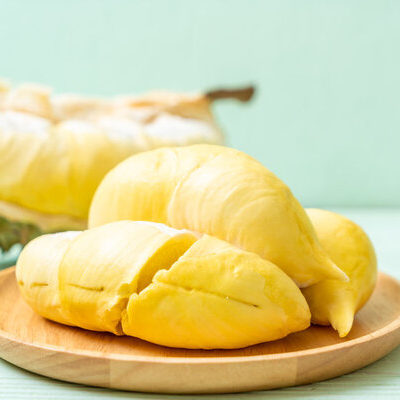
Durian
What is Durian?
Durian is a fruit that is popular in Southeast Asia. Though there are many varieties of the fruit, it is the Durio zibethinus L. variety that is cultivated for consumption. Due to its unique taste, it earned the title ‘king of fruits’ in the native regions where it is grown. It is a large, round fruit with a thorny green inedible outside and a yellowish pulp inside. The smell of the fruit is overpoweringly bad and has been likened to rotten onions, leading it to be banned in many public places in Southeast Asian countries.
- The king of fruit’s strong odor is thought to come from the rare amino acid, ethionine.
- Nonetheless, this fruit has a sweet, custard-like taste combined with some savory notes and a creamy texture.
Some popular ways to use this fruit include:
- Ice Cream
- Chips
- Dried
- Toffee
- Puffs
- Coffee
- Khao Niao Thu Lien
- Pie
- Chocolate
- Raw Fruit
Origin of durian
This fruit is native to the Indonesian islands of Sumatra and Borneo. There are 27 recognized varieties of the fruit: 19 are indigenous to Borneo, 7 to Sumatra, 11 to Malaysia, and 2 to Myanmar. There is some archaeological evidence that this fruit has been in existence for several thousands of years. The first written reference of durian is by Nicolo Conti, who traveled through Southeast Asia at the beginning of the 15th century. The name of the fruit is derived from the Malay word ‘duri’, which means ‘spine’. A cultural landmark, this has even been an inspiration for poetry and idioms in Malaysia over the years.
Nutrition
Durian is a powerhouse of micronutrients:

It is rich in minerals, such as copper, magnesium, manganese, potassium, and phosphorus. Also, it is rich in vitamins A and C, as well as in B vitamins, such as vitamin B6, niacin, folate, pantothenic acid, and riboflavin.
This fruit is a high-energy fruit that is also rich in good fats, and volatile compounds such as esters, thioacetals, thioesters, flavonoids, thiolanes, ascorbic acids, and carotenoids. Plus, it has probiotic effects. Regular consumption of this fruit is believed to help in controlling blood sugar levels, due to its potassium content. Additionally, the propionates in this fruit may help in lowering cholesterol.
Commercial production
The main global producers are Thailand, Malaysia, Indonesia, and the Philippines. Durian trees require a minimum of 5 years to bear fruit. In some climates, it may even take up to 15 years. These are often harvested before they are fully mature, in order to make them easy to transport and store. It takes the fruit 2 to 4 days to become ripe. These fruits remain fresh for up to 2 weeks, if kept in the refrigerator.
Durian recipes
This fruit is widely used in Southeast Asian cuisine. It lends itself to many dishes including juices, smoothies, and ice cream. Here are a few popular recipes:
- Fruit Ice Cream
- Durian Puree Cheesecake
- Durian Souffle
- Indonesian Pancake
- Durian Lapis Cake
- Mochi
- Sticky Rice
- Massaman Curry
- Mooncake
- Serawa
FDA regulations
This fruit is classified under tropical and subtropical fruit in the Electronic Code of Federal Regulations. There is no specific standard of identity for this fruit in the US. However, the ASEAN standard of identity for the fruit identifies the different varieties of this fruit and sets quality standards for them.
References
Joseph Stromberg, Why Does the Durian Fruit Smell So Terrible?, Smithsonian Magazine, https://www.smithsonianmag.com/science-nature/why-does-the-durian-fruit-smell-so-terrible-149205532/
“Discovering What Makes Durian Stink.” Phys.org, Phys.org, 28 Feb. 2020, phys.org/news/2020-02-durian.html.
Michael J. Brown, Durio – A Bibliographic Review, International Plant Genetic Resources Institute
https://www.bioversityinternational.org/fileadmin/_migrated/uploads/tx_news/Durio_654.pdf
Durian Production Guide, Department of Agriculture, Bureau of Plant Industry, Government of Philippines, http://bpi.da.gov.ph/bpi/images/Production_guide/pdf/DURIAN.pdf
A Aziz, Nur Atirah, and Abbe Maleyki Mhd Jalil. “Bioactive Compounds, Nutritional Value, and Potential Health Benefits of Indigenous Durian (Durio Zibethinus Murr.): A Review.” Foods (Basel, Switzerland) vol. 8,3 96. 13 Mar. 2019, doi:10.3390/foods8030096, https://www.ncbi.nlm.nih.gov/pmc/articles/PMC6463093/
